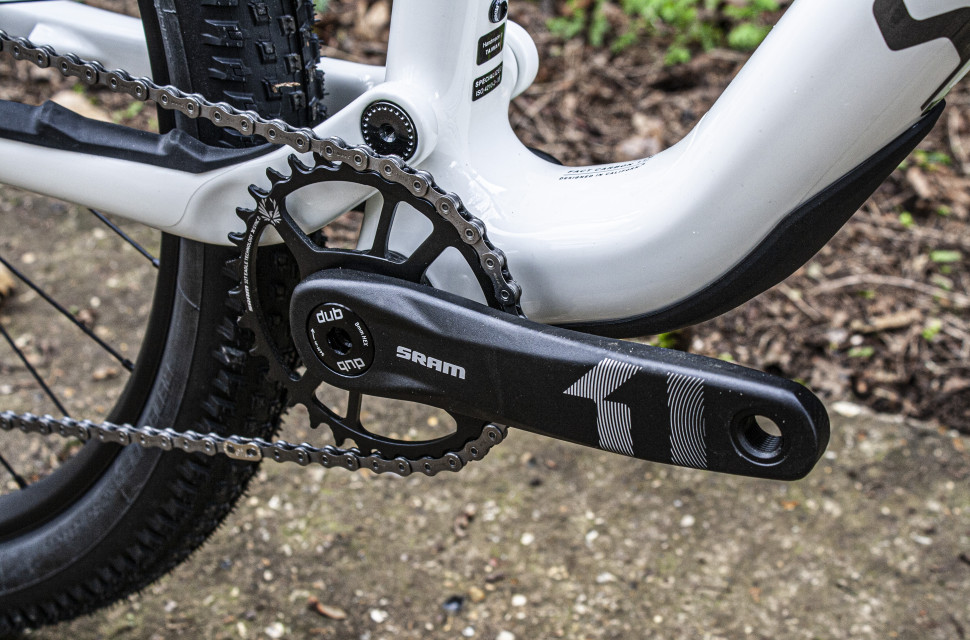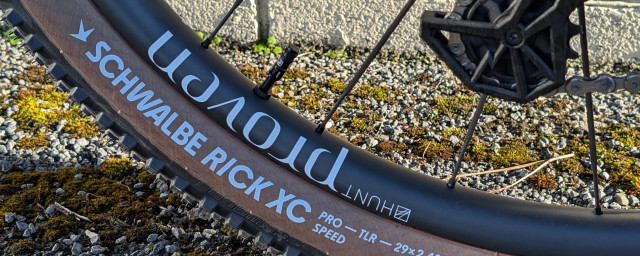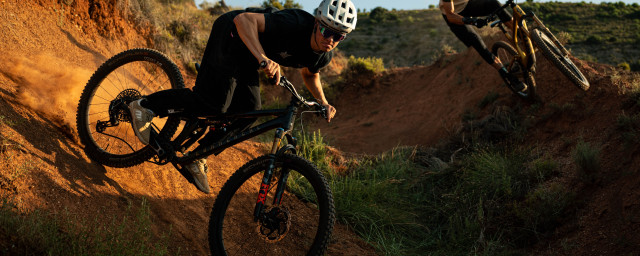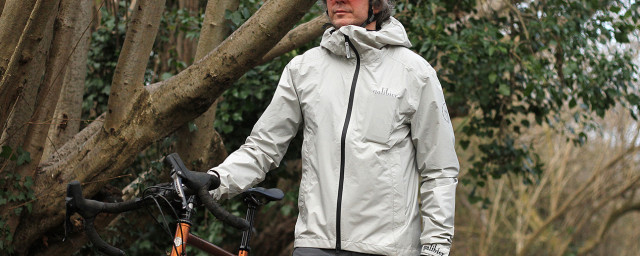What is the best crank length for off-road cycling?

Bike fit and component sizes. It’s a collection of numbers and measurements that riders obsess over, with exercise scientists and engineers providing rationale for new trends and products to add to the possible confusion.
- 9 tips to keep your suspension running sweeter for longer
- Five sneaky bike marketing terms you shouldn't trust
- Cycling snake oil: How to spot dodgy marketing claims
Riders might be more willing to experiment with handlebar geometry and size, for example, because swapping out and comparing different options is easy. Although it may not be the first change a rider might make, crank length has become a blisteringly hot topic in all kinds of cycling genres for a multitude of reasons.
Despite cranks being the primary levers that convert your pedalling motion to drivetrain force, riders might not think much about their length at first. For mountain bikers, crankarm length and terrain clearance are other issues to consider to reduce terrain strikes and possible crashes on technical descents.
Why crank length is influential – or is it?
The basic formula for pedalling performance is rider torque multiplied by cadence for power. Varying the lever that helps to convert that torque to pedalling force must have an influence. It’s fundamental physics, surely?
Imagine two mountain bikes ridden by riders of similar ability, fitted with different crank lengths. The rider pedalling with longer cranks can generate more power at a given gear by transferring the torque into a longer lever, right? Not quite. The problem is rotational speed.
A long crank arm is wonderfully effective for powering up and over a small rock ledge on a technical climb, when only a few rotations of crucial pedalling force are required. But they’re also fatiguing for prolonged efforts. Spinning that long crank arm at a consistent cadence requires more effort.
The margins between different crankarm standards are tiny, usually between 2.5- and 5mm. Three crank lengths dominate mountain and gravel bike builds, 170-, 172.5-, and 175mm. These lengths are sometimes distributed across frame sizes, from the smallest to largest, to give riders the best possible balance of comfort, fatigue resistance, knee- and joint care. That’s the theory, but some researchers have dispelled this, with studies that show crank length only influencing riders at extreme lengths, with ultra-short (120mm) or extremely long (220mm) cranks.
Tiny variants in crank length might not influence power or speed much, but they can make a big difference when riding technical terrain on your mountain or gravel bike. And it’s not about generating power or speed but reducing pedal strikes.
In road and gravel cycling, crank length has some influence on aerodynamics, with shorter cranks being more efficient as there's less surface area affected by wind. There's also a strong consideration in pedalling technique as shorter cranks (or cranks suited for the rider size) require less overall movement in the legs and hips, thus being more efficient and better in avoiding fatigue-related injuries
Do road rules apply off-road?
Mountain and gravel bikes have developed into a large enough market to generate new component standards and sizes, distinct from road bikes. That’s important because for the first few decades of mountain biking, technological development and rider needs were constrained by a habit of adopting road bike standards and attempting to adapt these to off-road bikes.
Road cyclists' crank length needs differ from those of off-road riders. On a road bike, steep climbs are conquered with different pedalling postures: riders vary between being seated and standing on the pedals. That’s not the case with mountain bikes. On a steep climb, mountain bikers may remain seated and rely on the granny gear of their 1x12 drivetrain.
Mountain bikers hardly ever need the flat terrain speed that road cyclists desire, but they require terrain clearance. There are no rocks, roots, or deep off-camber corner trenches to ride a road bike. But these trail features are everywhere on the best singletrack trails, where pedal strikes can create nasty crashes, especially when descending at speed.
Terrain clearance is so marginal that riding even marginally shorter cranks makes a significant difference. This is perhaps the most distinct difference and need for off-road riders, especially trail and enduro mountain bikers, compared to the legacy of crank lengths inherited from road cycling.
Geometry’s changed greatly – shouldn’t crank length, too?
Better trails, superior suspension, and advanced frame geometry have created a current market of mountain bikes, from 120mm downcountry frames to 170mm enduro machines - all hugely capable on even the steepest and most challenging terrain. But if frame geometry and fork offset have changed so much over the last decades, creating more descending capability and confidence, why are riders still on the same crank lengths?
Shorter cranks might be a bit more effort to climb on in very steep terrain, but you could always drop a chainring size down from 32- to 30t, and up the cassette’s granny gear to 52t, to create that extreme climbing gear ratio. Where shorter cranks are hugely beneficial, is descending.
Riders need to manage increasingly demanding trail consequences when speeds and gradient increase, with many potential terrain strikes. Being on cranks that are 5- or 10mm shorter than the legacy industry standard can be the difference between that sickening pedal strike, and the thrill of conquering a particularly technical section of trail with a clean run.
Some brands also opt for shorter cranks to compensate for a bike's low bottom bracket, another facet of design that lowers centre of gravity while instilling confidence and creating better performance while cornering. With a lower bottom bracket, what would be the lowest part of the crank is even closer to the ground and ever more prone to crank strikes. Shortening the crank, of course, provides a little more clearance while providing the benefits that a low BB offers.
How short should you go?
What are your options if the shortest standard fitment cranks that mountain bike brands fit are 170mm?
Established component brands have started producing much shorter cranks. These aren’t for kids. They are for adult riders who want to experience the singletrack surfing freedom of confidently shifting weight onto the pedals during a descent, steering and controlling the bike with your hips, without risking a pedal strike. Hope’s 155mm cranks create an opportunity for riders who want to experience the difference of riding with more terrain clearance when they need to vary their pedal position when rushing through a particularly technical trail section.
‘
But what about getting my outside foot down low, when cornering?’ That’s a valid question. Most mountain bike coaches teach a technique where riders apply their weight to the outside pedal when cornering. Theoretically, the longer that pedal’s crank arm is, the lower you can get your centre of gravity by dropping your outside foot to the 6 o’clock position of a 170mm crank, compared to a 155mm crank arm. However, the extreme outside-foot-down technique only works for smooth switchbacks, berms, and riders with advanced skill and flexibility.
Litter a corner with off-camber features, rocks, or roots, and a shorter crank that can clear terrain is best when applying weight to that outside pedal. Another example where shorter cranks are better is when mountain bikers or gravel riders are pedalling through technical terrain to sustain momentum on a climb or when navigating a water crossing, with a rocky bottom.
For mountain bikers and gravel riders, a guiding principle with crank lengths is to go shorter for enhanced terrain clearance. This is especially true for riders who often ride adventurous gravel bike routes or mountain bikers who use a lot of pedal position variation to steer and control their bikes when descending.
Think of the frame and cockpit geometry you are riding now, compared to what was standardized a decade ago. Frames have grown longer and slacker. Cockpits have grown shorter and wider. Shouldn’t your crank length change a bit, too?













